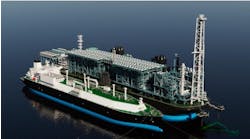P.2 ~ Global deepwater developments: real supply additions or just fighting decline?
View Article as Single page
US deepwater developments
Currently, all deepwater activity in the US is located in the Gulf of Mexico. Development of these resources took a hit with the Macondo blowout in 2010, and drilling deeper than 500 m (1,640 ft) was temporarily banned. However, by 2012 drilling activity was back at regular levels, normalizing that part of the market. In contrast to Brazil, where the capital investments in deepwater resources are dominated by Petrobras (90% 2014-2020), the US market has a broad operator landscape working toward first oil for these discoveries.
Based on their deepwater development agendas, the operators with the forecasted largest spend over the period 2014-2020 are Shell, followed by Chevron and Anadarko. Shell, with a total estimated spend of $19 billion, is currently undertaking the Cardamom Deep, South Deimos, and Stones developments. Going forward, the operator is expected to put the wheels in motion on a semi on Appomattox, with Vicksburg A and B as tiebacks. The operator is also understood to be reviewing the possible use of a TLP or a spar on the Vito discovery.
Chevron is wrapping up the Jack/St. Malo development with planned startup later this year. In 2015 production is also planned to start up on the ongoing Big Foot development. Toward 2020, there are possibilities for a second phase on Jack/St. Malo and Tahiti, in addition to the possible development of Buckskin and Moccasin, bringing total forecasted expenditure to $14 billion. Anadarko has both the Lucius and the Heidelberg spar under development, with estimated startup in 2014 and 2017 respectively. In addition, the development of the emerging Shenandoah mini basin is expected to be put into motion by 2020. In total, Anadarko's capex for its deepwater projects in the GoM is forecasted to be $10 billion from 2014 to 2020.
In addition to all the field developments under construction, BP has an interesting initiative running called the 20K project. Currently 15,000 psi sets the limit for what pressure the offshore drilling rigs can safely handle. The 20K project goal is to develop drilling and subsea production equipment that can handle reservoirs with pressures up to 20,000 psi. So far several industry participants have been included in the project, and/or awarded contracts, including Maersk Drilling, KBR, and FMC Technologies. BP is pushing for this technology development, among others, to unlock the potential in the high-pressure discoveries Kaskida and Tiber in the GoM. BP states the goal is to have the solutions ready within the next decade; and, that by pushing the operational envelope, new opportunities will emerge also in the other deepwater markets.
West Africa markets
West Africa as a deepwater region is primarily driven by Angola and Nigeria. Significant development activity is expected in the deepwaters of Angola in the years to come led by the ongoing development of Total's Kaombo project, Eni's Western and Eastern hub, and ExxonMobil's Kizomba Satellites Phase 2. One of the most exciting to-be sanctioned fields is Cobalt Energy's Cameia project, where the plan for development and operation was submitted in May 2014. Other interesting projects include Maersk's Chissonga, Chevron's Lucapa, and BP's West PCC project, where the operator is reported to be leaning toward a small leased FPSO.
In Nigeria, the potential new Petroleum Industry Bill (PIB) will continue to delay deepwater investments in the country until it is passed, if it is passed at all. It is viewed as unlikely to be passed before the Presidential and National Assembly elections scheduled for the Feb. 14, 2015. Although there are significant uncertainties regarding the PIB, project sanctioning has not stopped completely. Total sanctioned the giant Egina development in the summer of 2013, and one of the next projects that may come to the market next year is Shell's Bonga Southwest. However, until the PIB is passed, or shelved, the market developments in Nigeria will continue to move at a modest phase.
There is also some activity in the other West African countries, although relatively small compared to Angola and Nigeria. In Ghana, Tullow's sanctioned TEN development, Eni's possible Sankofa project, and Kosmos' to be sanctioned MTAB project will make up a larger share of the market, while in Congo it is the Moho Marine Nord that is the major development.


